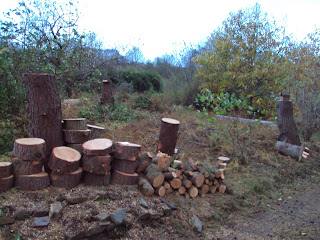The dreaded Phytopthera ramosa has struck Pembrokeshire's population of larch trees with vengeance,
so much so that it has arrived just 10 miles away from my forest garden. Now the larch is not a forest
garden tree, though its timber is a valuable soft wood commonly used for construction, indeed my
compost loo frame is made from it.
I inherited 3 Larch tees which are over 30 years old when I moved into the property 12 years ago and they have become a quite a prominent part of the garden architecture with their graceful swaying branches providing protection form the wind and shelter form the sun.
About 2 months ago I received an email from the Pembrokeshire Coast National Parks warning of the rapid spread of PR and that they have already had to clear fell a plantation of larch in the Gwuan valley as some of the trees had become infected.
I wrote back asking advice on my 3 trees especially as these were located near to my sweet chestnut trees and I knew that PR can affect these also.
My answer came a few days later saying that it would be wise to fell them as it is inevitable that they would become infected and that this would mean that I would loose the Chestnuts as well.
So in just one day my three 30 year old larches were felled and lo there was light and a lot of wood to process.
So I've lost the Larches but gained firewood and kindling and an awful lot of hard work.
For the record Phytopthera ramosa was first found in imported larch saplings in 2010 it also affects bilberry, possibly all the vaccinium family and the rhododendron family.
It affects Larch more veraciously due to the massive colonisation of the needles from the PR spores some 50,000 can be found on a single needle. The spores can spread in the air or in water and already infected trees have been found in almost every part of mainland UK.
Sadly there seems to be no let up in the spread and destruction of Larch and worse still the mild start to winter will insure an increased survival rate of the spores and an increase in infections next spring.
So far there is no news of possible methods to restrict the spread or discovery of any resistant clones.
 |
| Before felling with my Mulberry tree almost underneath. |
 |
| Wain from Aberteifi Tree services expertly dismantles the first one |

Shame about the larches Brucey but needs must eh. Enjoy the sawing.
ReplyDelete